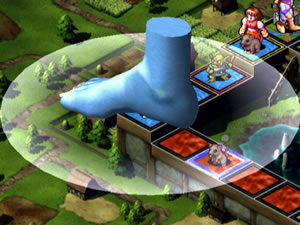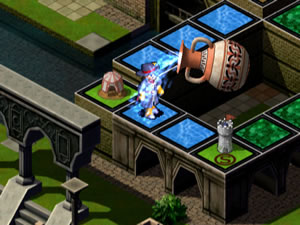Gotta play ’em all!
Once upon a time, card games belonged to intellectuals, old ladies and gamblers.
James Bond would win a small country in one hand of Baccarat. My grandma Alice
would spend her weeks laying the Bridge smack down at the local old folks home.
Everyday dorks would don their pseudo-suave flame shirts and dice cuffs for a
weekend of 10 dollar Blackjack in Vegas.
But these days, there seem to be more collectible card games out there than
ways to lose at poker. Just mentioning ‘cards’ and ‘games’ in the same sentence
leads to any number of insanely nerdy activities, from Pokemon
tournaments at Burger King to creepy Magic: The Gathering get-togethers in the
storeroom of a hobby shop. I even suckered my normal, sweet girlfriend into
spending WAY too much cash on a card game
based on the Game of Thrones
fantasy book series. Score one for the good geeks!
So
it comes as little surprise that video games would start to reflect the Yu
Gi Oh mania driving card games into complex new directions. It comes
as a much bigger surprise, though, that one of the best isn’t actually playable
in its physical form in the US. Culdcept is more than unpronounceable
– it’s also an addictive import from Japan that
blends card games and board games into an appetizing time burner.
The game is an odd cross between Magic and Monopoly. You collect cards and build decks, and then roll dice and move around on a game board, staking your claim to territories, which in turn can lead to profit if an opponent lands on them. The object is to make it back to the home castle with a certain amount of total magic. It might seem a little awkward and it is at first, but once you get the hang of the idea, you’ll start to like it.
The story, however, will only be appreciated by those suffering from severe
head trauma. You’re a Cepter, one who commands the cards, and in the main Story
mode must trek through various boards in an effort to thwart some evil being
intent on becoming an unstoppable god. The goddess Culdera, ultimate queen of
heaven or something, has sent you a weird talking stick with the face of a Japanese
hobbit to help you figure it all out. He does a terrible job, because even after
beating the Story mode entirely, I have no idea what the hell happened.
What I do know is that I pretty much got hooked on Culdcept
right from the start, and any fan of collectible card games probably will, too.
The game utilizes classic card game mechanics: each card has a playing cost
(the resource is imaginatively named “magic”) and the key to winning lies in
learning the abilities of each card and knowing when and how to use it. You
take over land by casting creature cards, which then gives you ownership of
the land tile. There are four main elements – fire, air, water and earth – and
by keeping your creature type and land type harmonious, your creature will gain
strength and hit point boosts.
The other ways to increase the value of your land is to raise it by spending magic to up the land level, much like Monopoly’s house/hotel system, or to gain enough of the same type of land in one area to build ‘chains.’ The strategy comes into play right away as you try to decide if it’s worth your time to cast an air creature like a Pegasus on an open earth tile, or to wait for a more opportune moment.
Buffing out the decks are item and spell cards, which can sway the tide of battle in a jiffy by changing strength or hit points, altering land levels instantly or even wiping creatures off the board without having to go into combat. With nearly 500 total cards and decks that must contain no more or less than 50 cards, there is a LOT of depth to discover here.
And that’s probably where the addiction part comes in. Culdcept
is filled with strategy, that’s for sure, but the lure comes in the form of
receiving new, cool cards to try out. You gain cards by both winning and losing,
so it pays to stay in the game even if you’re getting wiped out.
Which unfortunately will happen to even the best Culdcept
player, because no matter how you slice it, much of the game is founded in luck.
That’s sort of natural for a card game since drawing can be quite random, but
good deck building can usually offset the pain of a bad draw. It cannot, however,
offset the pain of rolling a one three times in a row, or rolling a three and
landing right on an enemy’s burliest “Boardwalk” without having the right cards
to kill off their creature and nab the land. Luck is one thing, but the luck
of the draw combined with the luck of the roll can lead to all kinds of unlucky
situations. Like a board game, Culdcept can turn on you in a heartbeat, leading
to the inevitable restart.
 Wait,
Wait,
you CAN’T restart? Nope. If you’re getting reamed, the only way to get un-reamed
is to either wait it out or literally shut off your PS2. There’s an option to
save mid-game, but that just puts off the inevitable. Once a game starts, it
either ends by way of the software or by you slamming on the hardware. Considering
that a game of Culdcept can last in upwards of two hours, it
can be insanely frustrating to play well for and hour and a half, then roll
bad a few times and lose all your land, plus any shot at winning, and then have
to sit there and continue playing rather than concede and start over.
There are really only two modes of play here: the Story mode and Versus mode, which just drops you into a match against computer and/or human players. You can tweak all sorts of rules, which means you can set up some quick 30 minute games to try to win some new cards. Sadly the game is not playable online, a feature that would have really made it more effective. Good luck finding another human being in your zip code who knows the cards as well as you do.
But the core gameplay is pretty solid, thanks to smart card design and cost. Very few cards are clearly overpowered, and a good player will find a use for even the lamest card in the catalog, though I wouldn’t recommend a deck full of goblins.
Besides, the other cards look cooler. The graphics are bright and cheery but
hardly cutting-edge, with squashed Japanese anime sprites running around on
2D boards. While the cut scenes are fine, the gods all look like rejects from
Cirque Du Soleil auditions, what with their giant hats and silly dangly
earrings. The real winner is the card illustration, which ranges from mediocre
(see Goblin) to simply outstanding (see Wereboar). Part of the fun is finding
new cards just to check out the sweet designs.
Amazingly, Culdcept‘s sound isn’t as heinous as you’d think.
The background midi track will unfortunately haunt your dreams, but most of
the speech is handled by text balloons and a pretty harmless announcer. The
cut-scenes, on the other hand, feature voice acting straight out of an NEC office
cubicle.
But I have to hand it to NEC – Culdcept is as good a card
game as I’ve played on the screen and can suck you in for hours on end. Some
will dislike the occasionally random luck swings, but the interesting design
and wealth of cards give it surprising depth. You probably won’t convince your
girlfriend or grandma Alice to play, but who needs them when you’ve just picked
up a rare Flame Lord, anyway?

-
Very addictive
-
Great card designs
-
Interesting gameplay
-
That can boil down entirely to luck
-
Which can really suck
-
Should be online










